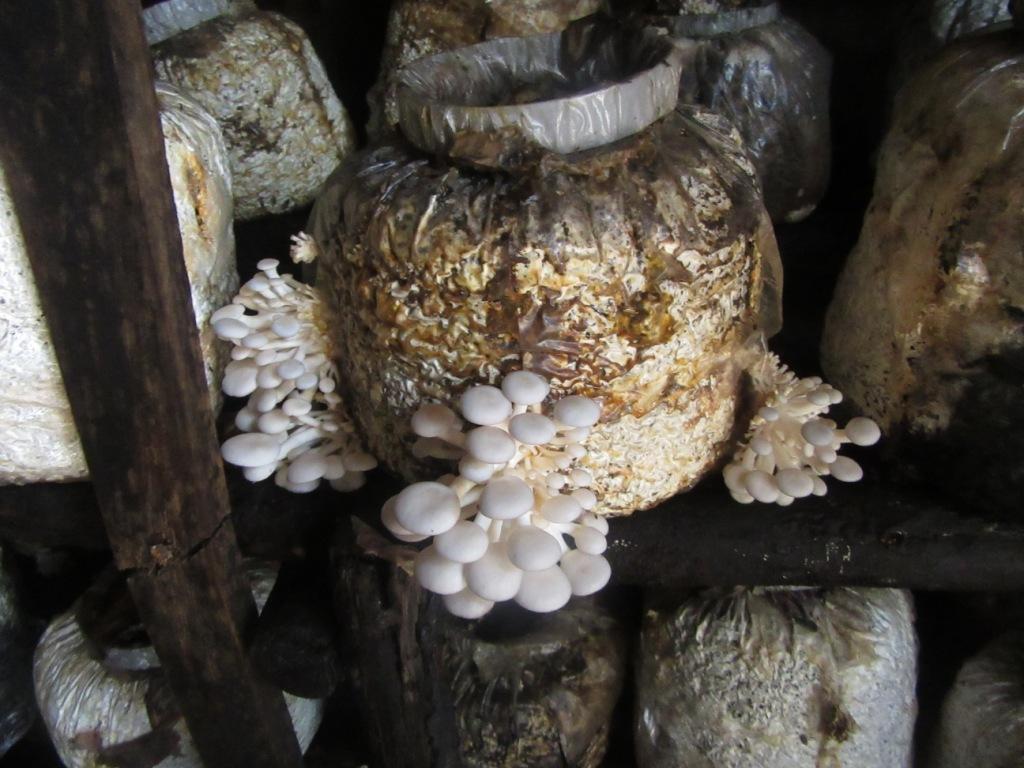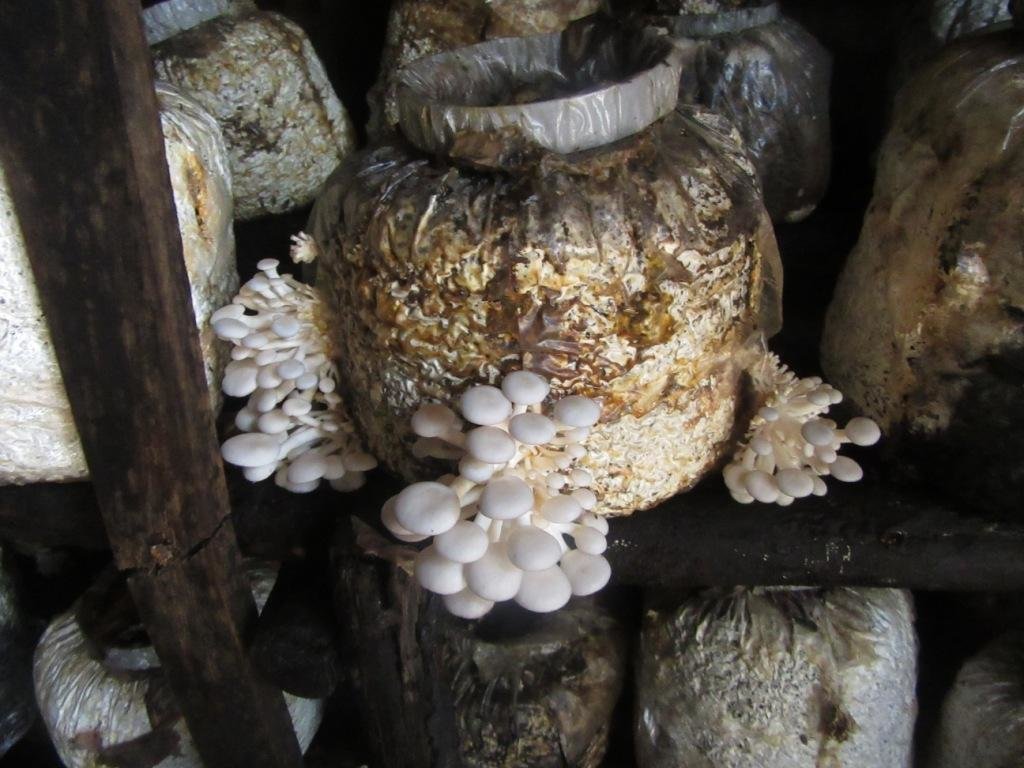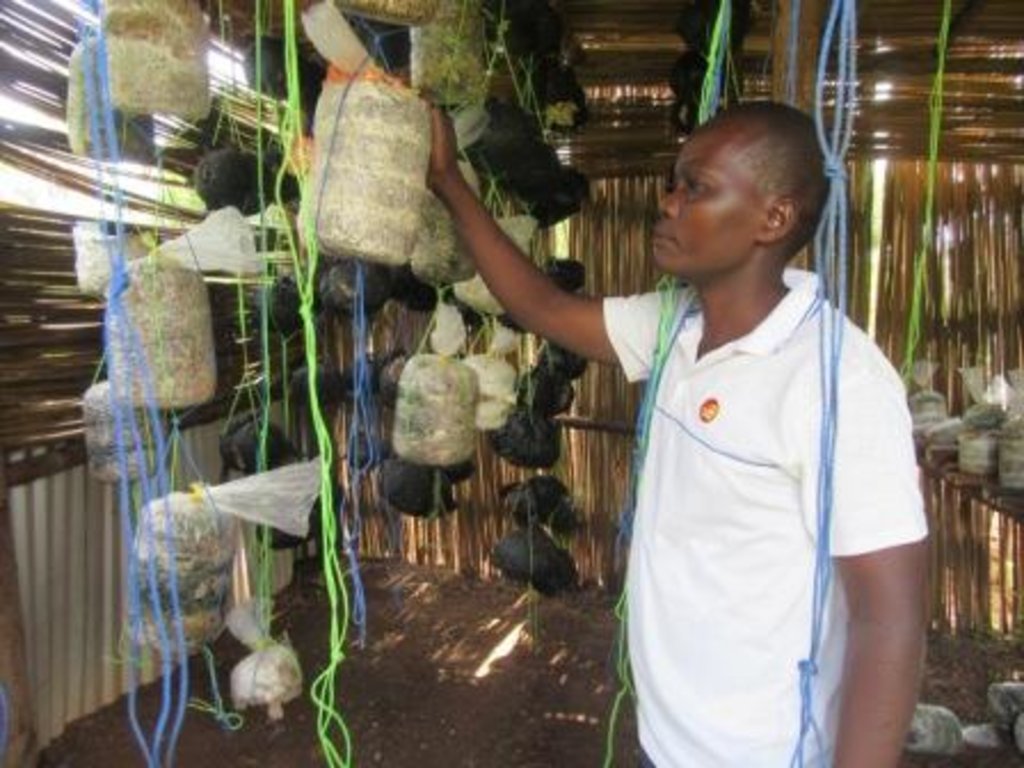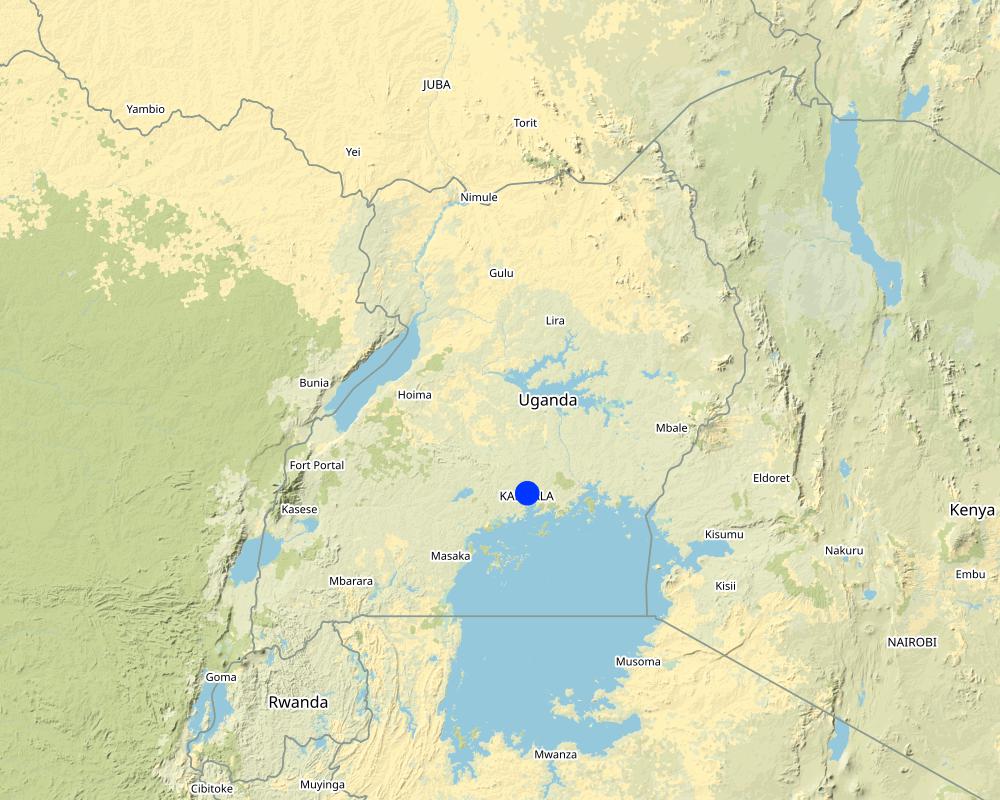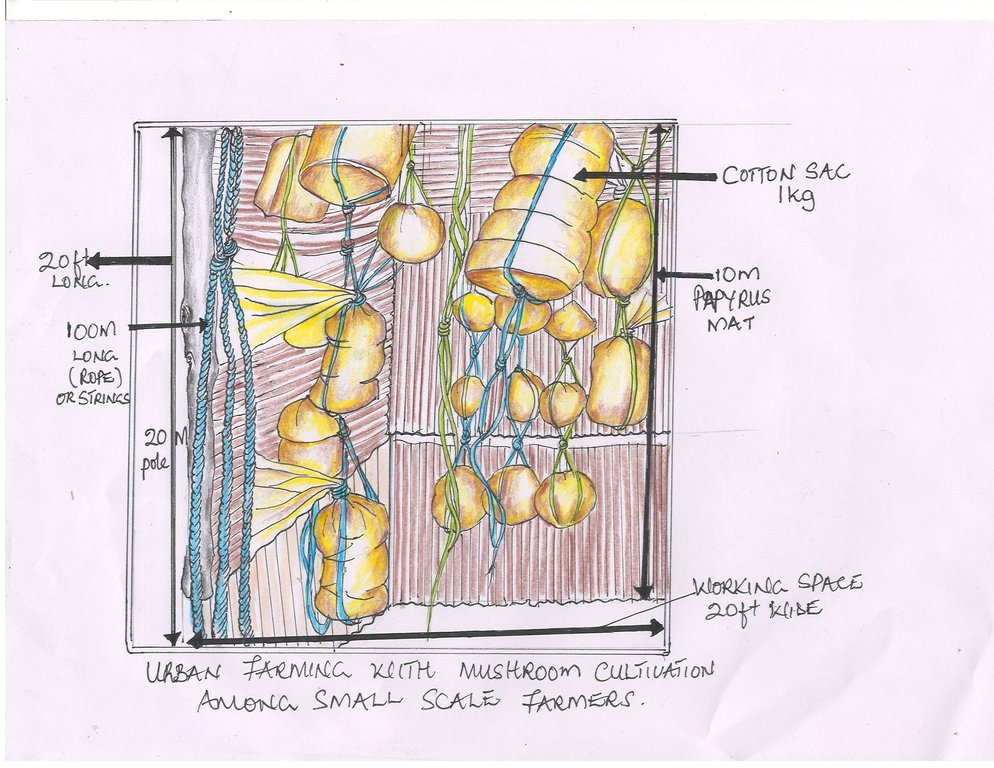Urban Farming with Mushroom Cultivation among Smallholder Farmers. [Uganda]
- Creation:
- Update:
- Compiler: Sarah Babirye
- Editors: Jalia Namakula, Kamugisha Rick Nelson
- Reviewers: Nicole Harari, Udo Höggel
Okulima obutiko
technologies_3450 - Uganda
View sections
Expand all Collapse all1. General information
1.2 Contact details of resource persons and institutions involved in the assessment and documentation of the Technology
Key resource person(s)
land user:
Grace Komuhangi
0782524325
Kamyokya farmers group
Kamyokya, Kisenyi Kampala
Uganda
Name of project which facilitated the documentation/ evaluation of the Technology (if relevant)
Scaling-up SLM practices by smallholder farmers (IFAD)Name of the institution(s) which facilitated the documentation/ evaluation of the Technology (if relevant)
National Agricultural Research Organisation (NARO) - Uganda1.3 Conditions regarding the use of data documented through WOCAT
When were the data compiled (in the field)?
12/5/2017
The compiler and key resource person(s) accept the conditions regarding the use of data documented through WOCAT:
Ja
1.4 Declaration on sustainability of the described Technology
Is the Technology described here problematic with regard to land degradation, so that it cannot be declared a sustainable land management technology?
Nee
Comments:
The technology is not problematic with regard to land degradation.
2. Description of the SLM Technology
2.1 Short description of the Technology
Definition of the Technology:
Mushroom (agaricus bisporus) cultivation is one of the profitable technologies promoted by small and medium scale farmers in urban setting fetching good returns on investment within a period of 30 days with the aim of obtaining tremendous nutritional benefits, employment and additional income gained by both farmers and suppliers of raw materials thus supporting the local economy and contributing to subsistence food security.
2.2 Detailed description of the Technology
Description:
Mushroom cultivation is a preferred and promoted technology by small and medium scale farmers with less land holdings. The technology has the portential to generate considerable nutritional benefits, employment and additional income which, in return, is invested in sustainable land management practices. To date, the demand for mushrooms increases as the result of a fast population growth having less income and food supply. Hence, a growing number of farmers adopt the mushroom production technology.
To establish such a technology, materials required include: cotton, a metallic drum (100 litres), a gunny bag of the size of 100kg, water, tarpuline, lime/maize brand, polyethene bags, banana leaf stock, cooking stove, firewood, mushroom seeds, tooth picks/nails and strings of approx. 100m length.
Listed below are the activities / procedures required for the establishment of a mushroom cultivation in a homestead.
-Water-soak the cotton into the drum and cover the drum with a gunny bag
-Remove the water out of the drum. The soaked cotton remains in the drum for around 2 hours
-Remove the soaked cotton on to a taurpline sheet and mix it with cultural lime/rice brand /maze brand that is placed on the taurpline
-Get black polythene bags and pack 1 kg of cotton into each polythene bag
-Place the banana leaf stock at the bottom of the drum and fill it with 20 litres of water
-Cut the gunny bag in the middle and cover the inside part of the drum to prevent burning of the cotton in the polythene bags while boiling
-Place the cotton in polythene bags into the drum and put the drum on the cooking stove to heat. The first line of polythene bags should be bent to prevent boiling water to enter the cotton
-Cover the drum tight with gunny bags
-Steam for around 2 hours
-Remove the firewood to cool until the next day
-Then remove the cooled cotton and place it on the tarpuline
-Buy mushroom seeds, smash the seeds (i.e, one pack of seeds mixes 2 gardens)
-Each kg of cotton mixed containing the mushroom seeds should be squeezed into the black polythene bags in a ball shape and tied on top
-Then get a tooth pick or a nail and pinch down 3 to 4 holes for air to come out
-Tie strings to the packed polythene bags and hang them for 14 days. (Strings enable sprouting on the gardens from all sides). Having moderate light, water needs to be applied twice a day or thrice in case of dry season during a period of 3 weeks
-After 7 days, the mushrooms start sprouting
-Leave the mushroom on the garden for 2-3 days before harvesting
-Once mushrooms are ripe, get a sharp knife and cut the stem carefully
On harvesting, the first week yields 8 Kg every second day, thereafter 3 kg of mushrooms every second day during the second month. Drums can be replaced every after 4 months so that the cost of maintenance is kept relatively low.
Mushrooms are a source of nutrients and proteins (Protein content, 3-7% when fresh and 25- 40% when dry). They are useful in preventing diseases and have medicinal values. Environmentally, the growing of mushrooms reduces pollution through bio-conservation and improves on crop production since harvested manure from the used mushroom ‘garden’ can be recycled as fertilizers for vegetable gardens at homes.
Despite the advantages, the technology faces various challenges: These include lack of a workplace (physical facility), lack of finance and skills on hygiene and sterilization, compost preparation, market challenges that include instability and decrease in sales prices of the products and inputs. Environmental factors like humidity, Ph, light and ventilation if not controlled may influence the growing process. Insects, diseases and animals due to the enclosed environment in which the mushrooms grow are a high risk. This may result in disease infestations like snails infestation.
However, maintenance costs of this technology are cheaper compared to establishment costs with minimum costs required for replacing worn out poles, replacing drums which can be at least every after 5 months.
2.3 Photos of the Technology
2.4 Videos of the Technology
Location:
Kamwokya, Kisenyi/Kampala
Name of videographer:
Babirye Sarah
2.5 Country/ region/ locations where the Technology has been applied and which are covered by this assessment
Country:
Uganda
Region/ State/ Province:
Kampala
Further specification of location:
Kamwokya, Kisenyi
Map
×2.6 Date of implementation
If precise year is not known, indicate approximate date:
- less than 10 years ago (recently)
2.7 Introduction of the Technology
- A friend
Comments (type of project, etc.):
Manure harvested from used up mushroom gardens is used as fertilizers in vegetable gardens.
3. Classification of the SLM Technology
3.1 Main purpose(s) of the Technology
- improve production
- create beneficial economic impact
- create beneficial social impact
3.2 Current land use type(s) where the Technology is applied

Settlements, infrastructure
- Settlements, buildings
3.3 Further information about land use
Comments:
The technology is practiced in buildings hence it doesn't require water from the rain or any irrigation source.
Number of growing seasons per year:
- 1
Specify:
Once a month, so 12 seasons in a year
3.4 SLM group to which the Technology belongs
- home gardens
3.5 Spread of the Technology
Specify the spread of the Technology:
- applied at specific points/ concentrated on a small area
Comments:
Mushroom are grown on a small area.
3.6 SLM measures comprising the Technology

other measures
Comments:
Indoor mushroom cultivation. Residues from the gardens on which mushrooms grow can be recycled for fertilizers which can later be applied onto lands or homestead gardens to improve on soil fertility.
3.7 Main types of land degradation addressed by the Technology

other
3.8 Prevention, reduction, or restoration of land degradation
Specify the goal of the Technology with regard to land degradation:
- not applicable
4. Technical specifications, implementation activities, inputs, and costs
4.1 Technical drawing of the Technology
4.2 Technical specifications/ explanations of technical drawing
The technical drawing shows the mushroom technology with the following dimensions and inputs required for establishment; a working place (room) of 20 feet long *20 feet wide
One timber of 10 m long length, one tarpaulin of 20 m length *20 m width, strings/ropes of 100m length in total, 10m papyrus mats (2) , polythene bags (of 1 kg ), nails (2 kgs), one drum and 5 bags of cement and 20 gardens.
4.3 General information regarding the calculation of inputs and costs
Specify how costs and inputs were calculated:
- per Technology unit
Specify unit:
A mushroom growing hut containing a number of mushroom gardens
Specify volume, length, etc. (if relevant):
20feet long *20feet wide for a room where mushrooms are grown as shown in the picture
other/ national currency (specify):
Uganda shillings
Indicate exchange rate from USD to local currency (if relevant): 1 USD =:
3600.0
Indicate average wage cost of hired labour per day:
3000/= per day
4.4 Establishment activities
| Activity | Type of measure | Timing | |
|---|---|---|---|
| 1. | Construction of a room of approximately 20*20feet | Structural | Once through out the buisness enterprise |
| 2. | Buying equipments like drum,cotton,garden,jerricans,tarpauline,polythen bags | Structural | Once through out the business enterprise |
| 3. | Hanging strings in the structure | Structural | Once through out the busness enterprise |
Comments:
Most of the activities for mushroom growing are cost effective. This is because these items and activities are done once on commencement.
4.5 Costs and inputs needed for establishment
| Specify input | Unit | Quantity | Costs per Unit | Total costs per input | % of costs borne by land users | |
|---|---|---|---|---|---|---|
| Labour | Making a structure | Man day | 1.0 | 30000.0 | 30000.0 | 100.0 |
| Labour | Hanging strings | Man day | 1.0 | 10000.0 | 10000.0 | 100.0 |
| Equipment | Drum | piece | 1.0 | 50000.0 | 50000.0 | 100.0 |
| Equipment | Cotton | piece | 2.0 | 25000.0 | 50000.0 | 100.0 |
| Equipment | Polythen bags | piece | 2.0 | 3000.0 | 6000.0 | 100.0 |
| Equipment | Jerricans | piece | 4.0 | 5000.0 | 20000.0 | 100.0 |
| Construction material | Strings | piece | 5.0 | 3000.0 | 15000.0 | 100.0 |
| Construction material | Poles | piece | 20.0 | 3000.0 | 60000.0 | 100.0 |
| Construction material | Nails | Kg | 3.0 | 5000.0 | 15000.0 | 100.0 |
| Construction material | Papyrus mats | piece | 10.0 | 7000.0 | 70000.0 | 100.0 |
| Other | Tarpuline | piece | 1.0 | 20000.0 | 20000.0 | 100.0 |
| Other | Seed packs | piece | 50.0 | 2000.0 | 100000.0 | 100.0 |
| Other | Maize brand | Kg | 10.0 | 1000.0 | 10000.0 | 100.0 |
| Other | Cultural lime | Kg | 1.0 | 15000.0 | 15000.0 | 100.0 |
| Other | Water | piece | 10.0 | 300.0 | 3000.0 | 100.0 |
| Other | Firewood | piece | 5.0 | 2000.0 | 10000.0 | 100.0 |
| Total costs for establishment of the Technology | 484000.0 | |||||
If land user bore less than 100% of costs, indicate who covered the remaining costs:
National Agriculrueal Advisory Services (NAAD supported her with the drum).
Comments:
The initial cost is relatively high for low income farmers although most acquire loans through farmer groups.
4.6 Maintenance/ recurrent activities
| Activity | Type of measure | Timing/ frequency | |
|---|---|---|---|
| 1. | Replace worn out poles | Management | Once a year |
| 2. | Replace old drums | Other measures | Once a year |
| 3. | Remove infestations by spraying snails | Agronomic | Once a year |
| 4. | Cleaning in the growing room | Other measures | Once a year |
Comments:
Most maintaince activities are not frequently made.
4.7 Costs and inputs needed for maintenance/ recurrent activities (per year)
| Specify input | Unit | Quantity | Costs per Unit | Total costs per input | % of costs borne by land users | |
|---|---|---|---|---|---|---|
| Equipment | Replace old poles | piece | 10.0 | 3000.0 | 30000.0 | 100.0 |
| Equipment | Replace old drums | piece | 50000.0 | 1.0 | 50000.0 | 100.0 |
| Equipment | Spray snails | man hour | 3000.0 | 1.0 | 3000.0 | 100.0 |
| Equipment | Cleaning the room in which mushrooms grow on their gardens | man hour | 5000.0 | 1.0 | 5000.0 | 100.0 |
| Total costs for maintenance of the Technology | 88000.0 | |||||
If land user bore less than 100% of costs, indicate who covered the remaining costs:
All costs are met by the farmer.
Comments:
Maintenance costs are less because items are replaced once in a year. This makes the technology cost-efficient.
5. Natural and human environment
5.1 Climate
Annual rainfall
- < 250 mm
- 251-500 mm
- 501-750 mm
- 751-1,000 mm
- 1,001-1,500 mm
- 1,501-2,000 mm
- 2,001-3,000 mm
- 3,001-4,000 mm
- > 4,000 mm
Specify average annual rainfall (if known), in mm:
1500.00
Agro-climatic zone
- humid
5.2 Topography
Slopes on average:
- flat (0-2%)
- gentle (3-5%)
- moderate (6-10%)
- rolling (11-15%)
- hilly (16-30%)
- steep (31-60%)
- very steep (>60%)
Landforms:
- plateau/plains
- ridges
- mountain slopes
- hill slopes
- footslopes
- valley floors
Altitudinal zone:
- 0-100 m a.s.l.
- 101-500 m a.s.l.
- 501-1,000 m a.s.l.
- 1,001-1,500 m a.s.l.
- 1,501-2,000 m a.s.l.
- 2,001-2,500 m a.s.l.
- 2,501-3,000 m a.s.l.
- 3,001-4,000 m a.s.l.
- > 4,000 m a.s.l.
Indicate if the Technology is specifically applied in:
- not relevant
5.3 Soils
Soil depth on average:
- very shallow (0-20 cm)
- shallow (21-50 cm)
- moderately deep (51-80 cm)
- deep (81-120 cm)
- very deep (> 120 cm)
Soil texture (topsoil):
- medium (loamy, silty)
Soil texture (> 20 cm below surface):
- medium (loamy, silty)
Topsoil organic matter:
- medium (1-3%)
5.4 Water availability and quality
Ground water table:
< 5 m
Availability of surface water:
good
Water quality (untreated):
good drinking water
Is water salinity a problem?
Nee
Is flooding of the area occurring?
Nee
5.5 Biodiversity
Species diversity:
- medium
Habitat diversity:
- medium
5.6 Characteristics of land users applying the Technology
Sedentary or nomadic:
- Sedentary
Market orientation of production system:
- mixed (subsistence/ commercial
Off-farm income:
- 10-50% of all income
Relative level of wealth:
- poor
Individuals or groups:
- individual/ household
Level of mechanization:
- manual work
Gender:
- women
Age of land users:
- elderly
5.7 Average area of land owned or leased by land users applying the Technology
- < 0.5 ha
- 0.5-1 ha
- 1-2 ha
- 2-5 ha
- 5-15 ha
- 15-50 ha
- 50-100 ha
- 100-500 ha
- 500-1,000 ha
- 1,000-10,000 ha
- > 10,000 ha
Is this considered small-, medium- or large-scale (referring to local context)?
- small-scale
5.8 Land ownership, land use rights, and water use rights
Land ownership:
- individual, not titled
Land use rights:
- individual
Water use rights:
- individual
5.9 Access to services and infrastructure
health:
- poor
- moderate
- good
education:
- poor
- moderate
- good
technical assistance:
- poor
- moderate
- good
employment (e.g. off-farm):
- poor
- moderate
- good
markets:
- poor
- moderate
- good
energy:
- poor
- moderate
- good
roads and transport:
- poor
- moderate
- good
drinking water and sanitation:
- poor
- moderate
- good
financial services:
- poor
- moderate
- good
6. Impacts and concluding statements
6.1 On-site impacts the Technology has shown
Socio-economic impacts
Production
crop production
land management
Income and costs
diversity of income sources
Comments/ specify:
She is now able to pay loans and facilitate the home.
Socio-cultural impacts
food security/ self-sufficiency
Comments/ specify:
She can now be able to pay loans and facilitate home errands.
health situation
Comments/ specify:
The mushrooms improve on the health conditions of human beings
situation of socially and economically disadvantaged groups
Comments/ specify:
There are many friendships created through the enterprise.
6.2 Off-site impacts the Technology has shown
Comments regarding impact assessment:
Not applicable to the technology
6.3 Exposure and sensitivity of the Technology to gradual climate change and climate-related extremes/ disasters (as perceived by land users)
Climate-related extremes (disasters)
Biological disasters
| How does the Technology cope with it? | |
|---|---|
| insect/ worm infestation | moderately |
6.4 Cost-benefit analysis
How do the benefits compare with the establishment costs (from land users’ perspective)?
Short-term returns:
positive
Long-term returns:
positive
How do the benefits compare with the maintenance/ recurrent costs (from land users' perspective)?
Short-term returns:
positive
Long-term returns:
positive
Comments:
There is high returns on investments.
6.5 Adoption of the Technology
- more than 50%
Of all those who have adopted the Technology, how many have did so spontaneously, i.e. without receiving any material incentives/ payments?
- 90-100%
Comments:
Most of the farmers support themselves.
6.6 Adaptation
Has the Technology been modified recently to adapt to changing conditions?
Nee
6.7 Strengths/ advantages/ opportunities of the Technology
| Strengths/ advantages/ opportunities in the land user’s view |
|---|
| Creates job opportunities. |
| Increases income to farmers. |
| Creates socio relations among farmers. |
| Strengths/ advantages/ opportunities in the compiler’s or other key resource person’s view |
|---|
| It requires a small piece of land to set up the enterprise. |
| Promotes soil conservation through fertilizer collected from used up gardens. |
| Improves on nutritional values hence human welfare improved. |
6.8 Weaknesses/ disadvantages/ risks of the Technology and ways of overcoming them
| Weaknesses/ disadvantages/ risks in the land user’s view | How can they be overcome? |
|---|---|
| Sometimes mushrooms fail to grow if proper parameters are not maintained. | Maintaining proper parameters in the growing room. |
| Snails may lead to infestations of the mushroom cultivation. | Continuous spraying of gardens. |
| If a farmer lacks skills, mushroom growth may be hard. | By acquiring skills. |
| Weaknesses/ disadvantages/ risks in the compiler’s or other key resource person’s view | How can they be overcome? |
|---|---|
| Its a tedious work. | Engaging all family members. |
| Price fluctuation of the products. | Encouraging farmers to produce a lot of mushrooms. |
| The initial capital may be higher for a beginner. | Acquiring capital from farmers groups. |
7. References and links
7.1 Methods/ sources of information
- field visits, field surveys
1
- interviews with land users
1
7.2 References to available publications
Title, author, year, ISBN:
Mushroom farming in Kenya: How you can make your first Ksh 1.000.000 in just 2 months.
Available from where? Costs?
http://www.kuzabiashara.co.ke/blog/mushroom-millions/
7.3 Links to relevant information which is available online
Title/ description:
Mushroom cultivation in Uganda,Kenya,Tanzania and Rwanda
URL:
https://www.aboutuganda.com/uganda/agriculture/mushroom-growing
Links and modules
Expand all Collapse allLinks
No links
Modules
No modules


